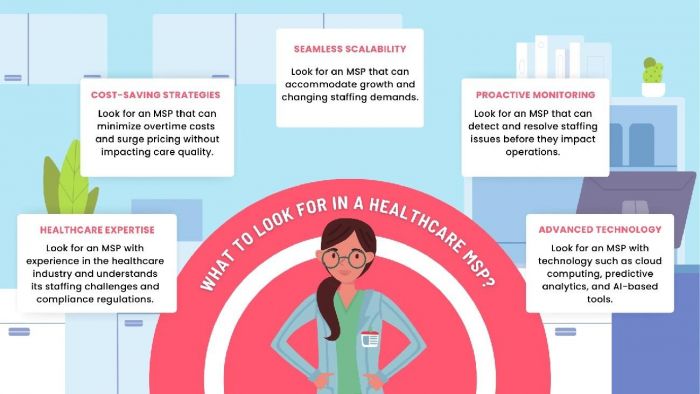Healthcare systems are facing one of the most significant staffing crises in modern history. By 2026, more than 6.5 million healthcare workers are expected to leave their positions permanently, with only 1.9 million new workers to replace them.
According to Yahoo Finance, the U.S. alone could face a shortfall of nearly 300,000 nurses by 2025, while physician shortages may exceed 187,000 by 2037.
This growing gap puts immense pressure on hospitals, clinics, and other care facilities to maintain high standards of patient care. In this article, we explore why effective medical staffing is essential for the success of healthcare organizations today and how it offers practical solutions to meet these urgent challenges.
The Growing Need for Resilient Healthcare Staffing
Healthcare systems worldwide face mounting pressure as staffing shortages reach crisis levels. The US healthcare system's biggest problem isn't about facilities or technology. The system just needs more healthcare professionals to provide care. Let's get into why this situation has reached a critical point and how it affects patient care.
Why staffing challenges are escalating
Healthcare workforce shortages existed well before COVID-19 due to several factors. The American health system will need 295,800 nurses by 2025. Physician shortages could reach 187,130 FTEs by 2037.
These factors fuel the growing crisis:
- Aging demographics: America has more seniors over 65 than ever before. This number could jump 73% by 2029. These patients often have multiple comorbidities that require complex care.
- Aging workforce: About one million registered nurses are over 50 years old. This means all but one of these nurses might retire within 10-15 years.
- Pandemic acceleration: COVID-19 triggered the largest exodus from the profession in 40 years. More than 100,000 nurses left their jobs.
- Burnout epidemic: Healthcare workers now handle heavier workloads and longer hours. They must care for patients with increasingly complex conditions.
Forbes highlights that staffing challenges are now considered one of the most urgent transformation drivers in healthcare, requiring not just temporary fixes but systemic solutions
Effect of workforce shortages on patient care
Staff shortages create serious risks for patients. Death rates climb 7% when nurses must care for more patients. Research shows hospitals with higher patient-to-nurse ratios report more deaths, rescue failures, and extended hospital stays.
Medical errors cause more than 250,000 deaths each year. These errors spike dramatically when facilities are short-staffed. Recent surveys reveal 34% of doctors worldwide saw more medical errors due to staff shortages and constant stress.
The effects reach far beyond these numbers:
- Patients wait longer for diagnosis and treatment
- Patient suffering increases
- Appointment and procedure delays grow longer
- Patient satisfaction drops
- Hospital-acquired infections occur more often
Rural and underserved communities struggle even more. They can't attract and keep healthcare professionals, which creates healthcare deserts and widens care gaps.
Creating flexible medical staffing solutions has become crucial to maintain quality care as these challenges grow.
Key Benefits of Integral Medical Staffing Solutions

Healthcare facilities are finding that partnerships with an experienced healthcare staffing company give them powerful advantages. Mutually beneficial alliances with staffing experts provide multiple benefits. These solutions help tackle today's complex healthcare challenges through specialized expertise and resources.
Rapid access to qualified professionals
Medical staffing agencies deliver swift solutions during staffing emergencies. Judge Healthcare fills urgent requests within days because of its nationwide talent networks and efficient screening processes. This quick access will give a seamless continuity of care during critical periods. Integral Medical Staffing provides:
- 24-hour customer service that supports emergencies
- Recruitment programs that maintain dependable care
- Complete screening with credential verification, background checks, and skills assessments
Flexibility to scale with demand
Patient volumes fluctuate regularly in healthcare facilities, which requires adaptable staffing approaches. Staffing agencies help scale workforce levels at the right time. Organizations can bring in temporary staff during busy periods to prevent burnout among permanent employees. On top of that, it ensures patients get specialized care without extra overhead costs.
Reduced administrative burden
Administrative workload takes valuable time away from patient care. Hiring processes hit an all-time high of 44 days in early 2023. Staffing agencies handle the entire recruitment lifecycle from finding candidates to checking credentials. Clinical teams can focus on their core duties while agencies manage reference checks, background screenings, and credential verification.
Improved patient outcomes
Optimal staffing levels boost patient care quality directly. Research shows hospitals with proper nurse-to-patient ratios have up to 20% lower mortality rates. Proper staffing leads to shorter hospital stays, fewer complications, and lower readmission rates. Healthcare facilities can reduce missed nursing care incidents that could lead to poor patient outcomes by maintaining the right staffing levels.
Long-Term Strategies for Sustainable Staffing
Healthcare organizations need better strategies than crisis management to build green staffing models that last. These organizations have discovered innovative ways to handle their changing workforce needs that work over the long run.
Flexible scheduling and shift management
Organizations that create adaptable work environments give their staff compelling reasons to stay. A McKinsey survey shows that 86% of nurses stay in their jobs because of flexibility. The most successful approaches include non-traditional hours, various shift lengths, team-based schedules, and compressed workweeks. Cleveland Clinic's Nursing Workforce Flexibility Taskforce shows what works. The taskforce launched several programs to assess and roll out scheduling options that benefit both units and individual staff members.
Investing in staff well-being and mental health
Healthcare workers deal with intense stress, and research reveals that 44% of physicians show at least one sign of burnout. Mental health support that works includes:
- Creating cultures of psychological safety
- Making mental health services available
- Breaking down help-seeking stigma
The Biden administration recognizes these challenges and has committed $103 million in American Rescue Plan funds to tackle burnout. The Dr. Lorna Breen Health Care Provider Protection Act adds $135 million over three years toward healthcare worker mental health programs. Organizations that make green staffing practices their priority are better equipped to tackle future workforce challenges and deliver better patient care.
Studies in behavioral health also suggest that inclusivity and psychological safety reduce workforce stress, which directly improves care delivery.
The Role of Staffing Agencies in Modern Healthcare
Staffing agencies have become trusted partners in today's changing healthcare world. They do much more than just place medical professionals. The healthcare industry just needs more than traditional recruitment as things get more complex. These organizations now work as detailed workforce management partners.
Credentialing and compliance assurance
Medical staffing agencies make sure healthcare facilities follow all regulations through careful credentialing. They check education, training, licenses, specialty certificates, and qualifications from original sources. These agencies run thorough background checks using special databases to keep patients safe from unqualified practitioners. This detailed process helps facilities avoid mistakes that can get pricey—replacing just one nurse can cost up to $64,000.
Mitigating staff burnout and turnover
Healthcare staffing partners help prevent burnout with eco-friendly workforce solutions. They give caregivers flexible scheduling options, which ranks high on professionals' reasons to stay with their employers. Many agencies also provide training and support to help their staff handle stress better. These approaches have helped reduce the high turnover rates that reached 41% in 2021.
Addressing specialized staffing needs
Medical staffing solutions excel at matching facilities with professionals who have specific clinical skills. Companies like Soliant and AMN Healthcare have built large networks of specialized talent ready to start work quickly. Healthcare facilities can find hard-to-recruit specialists without long hiring processes.
Enhancing diversity and inclusion
Smart staffing agencies actively promote diversity because they know it leads to better patient care. Organizations with detailed DEI programs report that diverse healthcare teams understand and serve different patient populations better. Teams that welcome everyone also show higher engagement levels, which leads to lower turnover and a more stable workforce.
Some providers even experiment with hybrid solutions that combine productivity apps with workforce scheduling, echoing insights from platforms like Liven that highlight how digital tools can improve efficiency and staff wellness simultaneously.
Conclusion
The healthcare staffing shortage is a complex challenge that impacts patient outcomes, workforce stability, and operational efficiency. Strategic partnerships with staffing agencies provide healthcare organizations with rapid access to qualified professionals, flexible workforce management, and reduced administrative burdens.
By investing in long-term solutions such as flexible scheduling, mental health support, and diversity initiatives, healthcare leaders can build a stronger, more resilient workforce. While the shortage will not disappear overnight, embracing comprehensive staffing strategies today ensures the delivery of safe, high-quality care for years to come.
Post Comment
Be the first to post comment!





